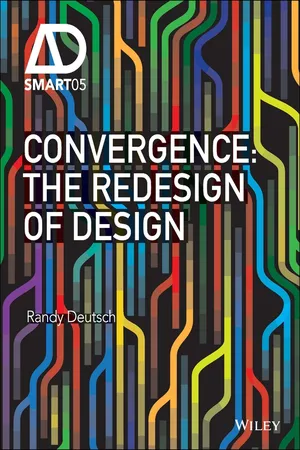
- English
- ePUB (mobile friendly)
- Available on iOS & Android
About this book
"There is today a pronounced and accelerated convergence in architecture. This convergence is occurring by doers not thinkers; in practice not academia; in building design, fabrication, and construction. It is about solution-centric individuals engaged in real time problem solving, not in abstractions. The nature of this convergence, where things are converging and what that means for architecture, is the subject of this book."
— from the Introduction Those working in architecture and engineering feel pressure to work faster, at lower cost, while maintaining a high level of innovation and quality. At the same time, emergent tools and processes make this possible. Convergence is about the firms, teams and people who thrive in this environment as a result of their ability to creatively combine and innovate. It seeks to answer several timely questions: What are the tools and work processes that are converging? How are individuals and organizations converging their tools and work processes? What challenges and benefits are they seeing? What is the ultimate endgame of this convergence? What skillsets and mindsets would someone need to develop to work effectively in this changing environment? What are the implications of convergence on the role of the designer, and on design? On how we design, build, fabricate, and construct? On how we work?
The book explains how convergence relates to, but ultimately differs from integration, consolidation, multi-tasking, automation, and other forms of optimization. The practice-based research builds upon the author's research in BIM and in the collaborative leveraging of data in design and fabrication. As an investigation and meditation on the impact of technology on the education and making of design professionals Convergence explains what is happening in the world of design, and discusses the implications for the future of education, training and practice.
Frequently asked questions
- Essential is ideal for learners and professionals who enjoy exploring a wide range of subjects. Access the Essential Library with 800,000+ trusted titles and best-sellers across business, personal growth, and the humanities. Includes unlimited reading time and Standard Read Aloud voice.
- Complete: Perfect for advanced learners and researchers needing full, unrestricted access. Unlock 1.4M+ books across hundreds of subjects, including academic and specialized titles. The Complete Plan also includes advanced features like Premium Read Aloud and Research Assistant.
Please note we cannot support devices running on iOS 13 and Android 7 or earlier. Learn more about using the app.
Information
CHAPTER 1
10 FACTORS LEADING TOWARD CONVERGENCE
There will be a stronger connection between what’s designed, built, and how it operates.—Philip Bernstein1
CONVERGENCE AND INTEGRATION

CONVERGENCE AND CONSOLIDATION

Table of contents
- Cover
- Copyright
- Title page
- Dedication
- Acknowledgements
- Introduction: Design in a Time of Simultaneity, Superintegration, and Convergence
- Chapter 1 10 Factors Leading Toward Convergence
- Chapter 2 Data and Intuition
- Chapter 3 Analytics and Models
- Chapter 4 Parametrics and Computation
- Chapter 5 Virtual and Physical
- Chapter 6 Conception and Construction
- Chapter 7 Design and Fabrication
- Chapter 8 Practical and Ineffable
- Epilogue: an Impending Period of Intense Change
- Index
- Eula